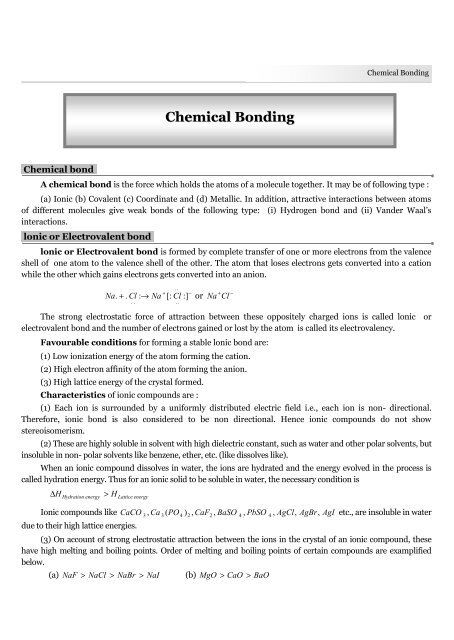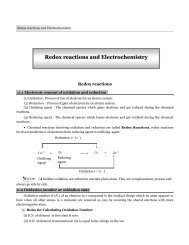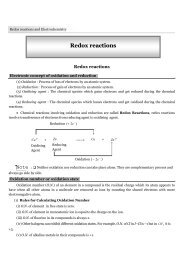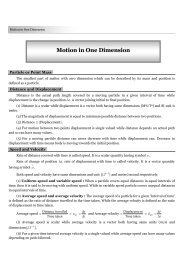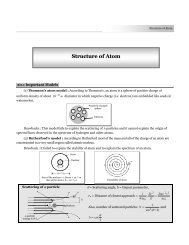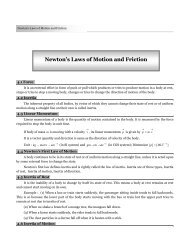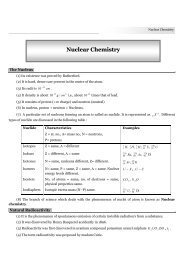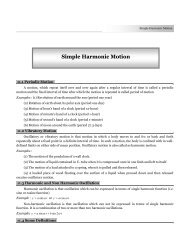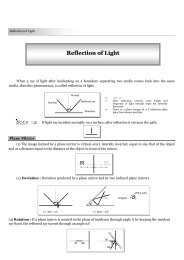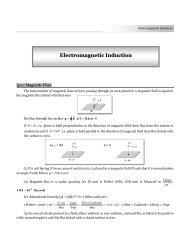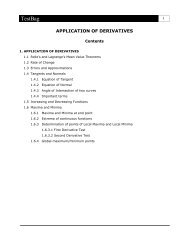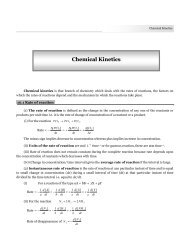Chemical Bonding - TestBag
Chemical Bonding - TestBag
Chemical Bonding - TestBag
Create successful ePaper yourself
Turn your PDF publications into a flip-book with our unique Google optimized e-Paper software.
<strong>Chemical</strong> <strong>Bonding</strong><br />
<strong>Chemical</strong> <strong>Bonding</strong><br />
<strong>Chemical</strong> bond.<br />
A chemical bond is the force which holds the atoms of a molecule together. It may be of following type :<br />
(a) Ionic (b) Covalent (c) Coordinate and (d) Metallic. In addition, attractive interactions between atoms<br />
of different molecules give weak bonds of the following type: (i) Hydrogen bond and (ii) Vander Waal’s<br />
interactions.<br />
lonic or Electrovalent bond.<br />
lonic or Electrovalent bond is formed by complete transfer of one or more electrons from the valence<br />
shell of one atom to the valence shell of the other. The atom that loses electrons gets converted into a cation<br />
while the other which gains electrons gets converted into an anion.<br />
. .<br />
Na.<br />
+ . Cl : → Na [: Cl :]<br />
. .<br />
+<br />
..<br />
..<br />
−<br />
or<br />
Na<br />
+ Cl −<br />
The strong electrostatic force of attraction between these oppositely charged ions is called lonic or<br />
electrovalent bond and the number of electrons gained or lost by the atom is called its electrovalency.<br />
Favourable conditions for forming a stable lonic bond are:<br />
(1) Low ionization energy of the atom forming the cation.<br />
(2) High electron affinity of the atom forming the anion.<br />
(3) High lattice energy of the crystal formed.<br />
Characteristics of ionic compounds are :<br />
(1) Each ion is surrounded by a uniformly distributed electric field i.e., each ion is non- directional.<br />
Therefore, ionic bond is also considered to be non directional. Hence ionic compounds do not show<br />
stereoisomerism.<br />
(2) These are highly soluble in solvent with high dielectric constant, such as water and other polar solvents, but<br />
insoluble in non- polar solvents like benzene, ether, etc. (like dissolves like).<br />
When an ionic compound dissolves in water, the ions are hydrated and the energy evolved in the process is<br />
called hydration energy. Thus for an ionic solid to be soluble in water, the necessary condition is<br />
∆H > H<br />
Hydration energy<br />
Lattice energy<br />
Ionic compounds like CaCO 3 , Ca 3 ( PO 4 ) 2 , CaF2<br />
, BaSO 4 , PbSO 4 , AgCl,<br />
AgBr,<br />
AgI etc., are insoluble in water<br />
due to their high lattice energies.<br />
(3) On account of strong electrostatic attraction between the ions in the crystal of an ionic compound, these<br />
have high melting and boiling points. Order of melting and boiling points of certain compounds are examplified<br />
below.<br />
(a) NaF > NaCl > NaBr > NaI (b) MgO > CaO > BaO
<strong>Chemical</strong> <strong>Bonding</strong><br />
(4) Ionic compounds conduct electricity in solution as well as in molten form (fused state) because ions<br />
become mobile. These free ions are able to move under the influence of an electric field and thus act as carriers of<br />
current. In solid state, they are bad conductors as the ions are tightly held.<br />
(5) In solution, ionic compounds show ionic reactions which are quite fast and instantaneous<br />
Energetics of formation of ionic bond are represented by the Born-Haber cycle which is as followers :<br />
∆H sub.<br />
+ I.E.<br />
Na (s)<br />
+<br />
1<br />
Cl 2 ( g)<br />
2<br />
1<br />
2<br />
Na (g)<br />
Cl(g)<br />
∆H diss<br />
−<br />
− e + e ( −E.<br />
A)<br />
− U<br />
(Lattice energy)<br />
Na + (g)<br />
Cl − (g)<br />
Na<br />
+<br />
Cl<br />
−<br />
(s)<br />
The heat of formation of an ionic solid is net resultant of the above changes.<br />
1<br />
∆ H f = ∆H<br />
sub.<br />
+ ∆H<br />
diss + I.<br />
E.<br />
− E.<br />
A.<br />
− U<br />
2<br />
The lattice energy is one of the deciding factors of ionic bond formation. It depends upon :<br />
(1) Size of the ions : Smaller the size of the ions greater is the attractive forces between the ions and<br />
higher is the lattice energy.<br />
(2) Charge on the ions : Greater the charge on ions greater will be attractive forces between the ions<br />
and hence greater is the value of lattice energy<br />
For example, lattice energy of bi-bivalent ions > bi-uni or uni-bivalent ions> uni-univalent ions. Order of<br />
lattice energy of certain compounds are :<br />
(a) LiX > NaX > KX > RbX > CsX (where X = F, Cl, Br or I); (size of alkali metal increases)<br />
(b) MgO > CaO > SrO > BaO (size of alkaline earth metal increases)<br />
(c) MgCO 3 > CaCO 3 > SrCO 3 > BaCO 3<br />
(size of cation increases)<br />
(d) Mg ( OH ) 2 > Ca(<br />
OH ) 2 > Sr(<br />
OH ) 2 > Ba(<br />
OH ) 2<br />
(size of cation increases)<br />
As lattice energy increases, melting and boiling points of ionic compounds increases. This is due to strong<br />
electrostatic force of attraction.<br />
Fajan Rules.<br />
In Ionic bond, some covalent character is introduced because of the tendency of the cation to polarise the<br />
anion. In fact cation attracts the electron cloud of the anion and pulls electron density between the two nuclei.<br />
+<br />
–<br />
+<br />
–<br />
CATION<br />
ANION<br />
According to Fajan rules, the magnitude of covalent character in the ionic bond depends upon the extent<br />
of polarisation caused by cation. In general,<br />
(1) Smaller the size of cation, large is its polarising power.<br />
POLARISED<br />
ELECTRON CLOUD<br />
OF ANION
2<br />
<strong>Chemical</strong> <strong>Bonding</strong><br />
(2) Among two cations of similar size, the polarising power of cation with noble gas configuration<br />
6<br />
10<br />
( ns np nd ) is larger than cation with noble gas configuration ( ns ) e.g., Polarising power of<br />
than<br />
+<br />
K<br />
(3) Larger the anion, more will be its polarisability<br />
Covalent bond.<br />
2 np 6<br />
+<br />
Ag is more<br />
Covalent bond is formed by mutual sharing of electrons so as to complete their octet or duplet in case of<br />
H, Li and Be. Depending upon whether one, two and three electrons are shared by each atom, single, double<br />
and triple bonds are respectively formed. The number of electrons contributed by each atom for sharing is<br />
called its Covalency.<br />
The formation of covalent bonds is best explained by a new approach according to which sharing of<br />
orbitals is possible only with overlapping. According to this concept, the formation of covalent bond involves<br />
the overlapping of half filled atomic orbitals of the atoms participating in bonding. The atomic orbitals<br />
undergoing overlapping must have electrons with opposite spin.<br />
When two half-filled atomic orbitals overlap along their internuclear axis, the bond formed is called the<br />
sigma bond (or -bond) It may be formed by the overlap of two s-orbitals, two p-orbitals, one s- and one p-<br />
orbital. Accordingly these bonds are dasignated as s-s, p-p and s-p sigma bonds. On the other hand, covalent<br />
bond formed by sideways or lateral overlap of p-orbitals is called pi-bond (or –bond). It may be noted that<br />
(1) All single bonds are –bonds.<br />
(2) Multiple bonds contain one –bonds and the rest are –bonds.<br />
(3) A –bond is never formed alone. First –bonds is formed and then the formation of the –bond takes<br />
place.<br />
(4) A sigma bond is always stronger than pi-bond because the extent of overlapping of atomic orbitals<br />
along internuclear axis is greater than sideways overlapping.<br />
Characteristics of covalent compounds are :<br />
(1) Covalent compounds have low melting points and boiling points. As such they may be gases, liquids or<br />
low melting solids.<br />
(2) They are insoluble in water but soluble in organic (non-polar) solvents<br />
(3) They do not conduct electricity in the solution or the molten state.<br />
(4) Since covalent bonds are rigid and possess directional characteristics, therefore, they show<br />
stereoisomerism.<br />
(5) Their reactions are slow and molecular in nature and never proceed to completion.<br />
Coordinate or Dative bond.<br />
This type of bond formation occurs by one sided sharing of electrons, i.e., one atom donates a pair of<br />
electrons while the other simply shares it so as to complete its octet. The atom that donates a pair of electrons<br />
is called the donor while the other which accepts these electrons is called the acceptor. The coordinate bond<br />
is usually represented by an arrow pointing from the donor towards the accept
<strong>Chemical</strong> <strong>Bonding</strong><br />
For example,<br />
H<br />
|<br />
+<br />
H — N : → H or<br />
|<br />
H<br />
⎡ H ⎤<br />
⎢ | ⎥<br />
⎢H — N — H ⎥<br />
⎢ | ⎥<br />
⎢<br />
⎥<br />
⎣ H ⎦<br />
+<br />
Coordinate bond is also present in SO 2 , SO 3,<br />
O3,<br />
H 3O<br />
, NO 3 or HNO 3<br />
etc.<br />
This coordinate bond has some polar character, it is also called dative or semi-polar bond.<br />
In terms of VB theory, a coordinate bond is formed by overlap of a fully filled orbital containing a lone<br />
pair of electrons with an empty orbital of another atom.<br />
Examples of molecules in which all the three types of bonds, i.e., ionic, covalent and coordinate bonds are<br />
CuSO . 5H<br />
O,<br />
NH Cl,<br />
K [ Fe CN ] Cu( NH ) SO etc. besides these bonds, CuSO 4 . 5H<br />
2O<br />
also<br />
present : ( )<br />
contains a H-bond.<br />
4 2 4 4<br />
6<br />
,<br />
Characteristics of coordinate compounds are :<br />
[<br />
3<br />
]<br />
4<br />
Since coordinate compounds are in fact covalent compound, therefore, their properties are almost similar<br />
to those of covalent compounds. For example,<br />
(1) Like covalent compound, they are insoluble in H 2 O<br />
(2) They usually do not conduct electricity.<br />
4<br />
+<br />
−<br />
but are soluble in organic solvents.<br />
(3) Their melting and boiling points are higher than those of covalent compounds but lower than those of<br />
ionic compounds.<br />
(4) Like covalent bonds, coordinate bonds are directional and hence these compounds also exhibit<br />
stereoisomerism<br />
Bond formula or Dash formula of molecules showing different type of bonding.<br />
(1) Compounds having electrovalent bonds only (2) Compounds having covalent bonds only<br />
Molecular formula / Dash formula<br />
NaCl /<br />
2<br />
Na<br />
+ Cl −<br />
−<br />
MgCl / Cl Mg<br />
2<br />
−<br />
CaCl / Cl Ca<br />
+<br />
+ +<br />
+ +<br />
MgO / Mg + O<br />
+<br />
Na 2 S / Na S<br />
2<br />
−<br />
CaH / H Ca<br />
AlF / F<br />
3<br />
−<br />
−−<br />
+ +<br />
3+<br />
Al F<br />
F<br />
−<br />
Cl<br />
Cl<br />
−−<br />
Na<br />
H<br />
−<br />
−<br />
+<br />
−<br />
−<br />
Molecular formula / Dash formula<br />
HCl /<br />
H − Cl<br />
H 2 O / H − O − H<br />
H 2 S / H − S − H HCN / H − C ≡ N<br />
NH 3<br />
/<br />
4<br />
C / H − C ≡ C − H<br />
2 H 2<br />
H<br />
|<br />
H − N<br />
|<br />
H<br />
H<br />
|<br />
CH / H − C − H<br />
|<br />
H<br />
H H<br />
C / C C<br />
| |<br />
2 H 4<br />
|<br />
H<br />
H<br />
C 2 H 6<br />
/<br />
H H<br />
|<br />
H − C − C − H<br />
|<br />
H<br />
PCl 3<br />
/<br />
=<br />
3<br />
|<br />
|<br />
|<br />
H<br />
Cl<br />
Cl − P<br />
|<br />
|<br />
Cl<br />
H<br />
|<br />
PH / H − P<br />
|<br />
H
<strong>Chemical</strong> <strong>Bonding</strong><br />
(3) Compounds having electrovalent & covalent<br />
bonds<br />
Molecular formula / Dash formula<br />
NaOH / Na<br />
KCN / K<br />
+<br />
+<br />
[ O − H]<br />
[ C ≡ N]<br />
−<br />
−<br />
2−<br />
⎡ ⎤<br />
++<br />
CaCO 3<br />
/<br />
⎢ ⎥<br />
Ca<br />
⎢<br />
O − C−<br />
O<br />
|| ⎥<br />
⎢⎣<br />
O ⎥⎦<br />
(4) Compounds having covalent & coordinate bonds<br />
CO / C = O N 2 O / N ≡ N → O<br />
N 2O 3<br />
/ O = N − N = O<br />
↓<br />
O<br />
HClO / H − O − Cl → O<br />
3<br />
O<br />
H 2O 2<br />
/ H − O − O − H or H O → O<br />
−<br />
2<br />
−<br />
NO / O − N = O<br />
H<br />
HNO / H − O − N = O<br />
2<br />
↓<br />
2<br />
−<br />
|<br />
SO / O ← S = O<br />
N 2O 4<br />
/ O = N − N = O<br />
↓ ↓<br />
O O<br />
N 2 O 5<br />
/ O = N − O − N = O<br />
↓ ↓<br />
O O<br />
HNO 3<br />
/ H − O − N = O<br />
↓<br />
O<br />
− −<br />
NO 3 / O − N = O SO 3<br />
/ O ← S = O<br />
↓<br />
↓<br />
O<br />
O<br />
SOCl 2<br />
/<br />
HIO 3<br />
/ H − O − I → O<br />
O ← S − Cl<br />
↓<br />
|<br />
O<br />
Cl<br />
Cl<br />
SO 2Cl 2<br />
/ O S → O<br />
←<br />
|<br />
|<br />
Cl<br />
O<br />
↑<br />
HClO 4<br />
/ H − O − Cl → O<br />
↓<br />
O<br />
O<br />
↑<br />
H 2SO 4<br />
/ H − O − S − O − H<br />
↓<br />
O<br />
Molecular formula / Dash formula<br />
2−<br />
SO 3 /<br />
−<br />
H<br />
−<br />
−<br />
2SO 3<br />
/ O − S − O<br />
O − S − O<br />
↓<br />
↓<br />
O<br />
O<br />
O<br />
↑<br />
2−<br />
SO 4 / H − O − S − O − H<br />
↓<br />
O<br />
O<br />
H 3 PO 4<br />
/ ↑<br />
H − O − P − O −<br />
|<br />
H<br />
O<br />
|<br />
H<br />
O O<br />
H 4 P2<br />
O7<br />
/ ↑ ↑<br />
H − O − P − O − P − O − H<br />
| |<br />
O O<br />
| |<br />
H H<br />
H<br />
H / H − O − P − O − H<br />
3 PO 3<br />
Al Cl /<br />
2 6<br />
( Anhydrous )<br />
Cl<br />
Cl<br />
O 3<br />
/<br />
O<br />
Al<br />
O<br />
|<br />
↓<br />
O<br />
Cl<br />
(5) Compounds having electrovalent, covalent &<br />
coordinate bonds<br />
Cl<br />
O<br />
Al<br />
Molecular formula / Dash formula<br />
4k<br />
⎡ H ⎤<br />
⎢<br />
|<br />
⎥<br />
NH 4 Cl / ⎢H<br />
− N → H ⎥<br />
|<br />
⎢<br />
⎥<br />
⎣ H ⎦<br />
K 4 [ Fe(<br />
CN ) 6 ] /<br />
+<br />
⎡<br />
⎢<br />
⎢<br />
N ≡ C<br />
⎢<br />
⎢<br />
⎢N<br />
≡ C<br />
⎢<br />
⎣<br />
C ≡ N<br />
Fe<br />
C ≡ N<br />
+<br />
Cl<br />
Cl<br />
Cl<br />
−<br />
⎤<br />
C ≡ N<br />
C ≡ N<br />
⎥<br />
⎥<br />
⎥<br />
⎥<br />
⎥<br />
⎥<br />
⎦<br />
4 −<br />
Note : Molecules like<br />
CuSO 4 . 5H2O<br />
[ Cu(<br />
NH 3)<br />
4 ] SO 4 also have all three types<br />
of bonding.<br />
−
<strong>Chemical</strong> <strong>Bonding</strong><br />
Hybridization.<br />
The concept of hybridization was introduced to explain the shapes of molecules. It involves the<br />
intermixing of two or more atomic orbitals of slightly different energies but of the same atom so that a<br />
redistribution of energy takes place between them resulting in the formation of an equal number of new<br />
orbitals (called hybrid orbitals) having same energy, size and shape. It may be noted that:<br />
(1) Both half – filled and completely filled orbitals can participate in hybridization<br />
(2) Hybridisation never takes place in isolated atoms but occurs only at the time of bond formation.<br />
(3) Hybrid orbitals form stronger bonds than pure atomic orbitals.<br />
Types of hybridization<br />
Type of<br />
Hybridisatio<br />
n<br />
Character<br />
sp s -character = 50%,<br />
p -character = 50%.<br />
2<br />
sp s -character = 33.33%,<br />
p -character = 66.67%<br />
3<br />
sp s-character = 25%,<br />
p-character = 75%<br />
(as s-character<br />
decreases,<br />
p-character increases,<br />
bond angle decreases).<br />
sp 3 d<br />
s-character = 20%,<br />
p-character = 60%,<br />
d-character = 20%<br />
Shape of the<br />
molecule or ion<br />
180 o<br />
: A<br />
:<br />
Linear<br />
. .<br />
A<br />
120 o<br />
: :<br />
Triangular planar<br />
109 o 28′<br />
A<br />
: :<br />
:<br />
. .<br />
. .<br />
Tetrahedral<br />
120 o<br />
. .<br />
90 o :<br />
A<br />
. .<br />
. .<br />
Trigonal bipyramidal<br />
Example<br />
BeF2 , BeH 2 , CO 2 , C 2 H 2 ,<br />
HCN HgCl , CS , N ,<br />
, 2 2 2O<br />
Hg 2Cl<br />
2 , [ Ag(<br />
NH 3 ) 2 ]<br />
BF 3, SO 2<br />
, SO 3, C 2 H 4 ,<br />
2−<br />
−<br />
O<br />
CO 3 , NO 3 , H − C − H,<br />
+<br />
CH 3 , AlCl 3, Benzene,<br />
graphite, C 2Cl 4, C 2H 2Cl 2,<br />
C 2 H 5CHO<br />
, BeCl 2.<br />
CH 4, CCl 4<br />
, SiF 4, H 2O,<br />
NH 3, H 3O + ,<br />
+<br />
||<br />
−<br />
ClO 4 ,<br />
−<br />
+<br />
2−<br />
SO 4 ,<br />
NH 4 ,[<br />
BeF4<br />
] , ClO 3 , NF3<br />
,<br />
XeO 3 , XeO 4 , CH 3 , 2 ,<br />
−<br />
−<br />
− NH −<br />
[ AlCl4 ] ,[ PH4]<br />
, SnCl 4,<br />
Diamond, Silica,<br />
+<br />
+<br />
H 3 O ,<br />
AsCl 3, Si(CH 3) 4, SiC,<br />
[BF 4] – , ClO −<br />
2 ,<br />
NH +<br />
4 , SF − −<br />
2<br />
, ClO 4 , NH 2<br />
.<br />
XeO 3F 2, XeF 2, ClF 3, SF 4,<br />
PCl 5, PF 5, AsF 5, SbCl 5,<br />
PCl<br />
4<br />
+ −<br />
, PCl6<br />
.
<strong>Chemical</strong> <strong>Bonding</strong><br />
sp 3 d 2 s-character = 16.66%,<br />
p-character = 49.98%,<br />
d-character = 33.33%<br />
:<br />
. .<br />
A<br />
90 o<br />
:<br />
SF 6 , MoF 6, XeF 4 , BrF 5,<br />
XeOF 4, [BiCl 6] – , [PF 6] – ,<br />
[Co(NH 3) 6] 3+ .<br />
:<br />
. .<br />
:<br />
Octahedral<br />
sp 3 d 3 s-character = 14.28%,<br />
p-character = 42.86%,<br />
90 o A<br />
: 90 o<br />
. . . .<br />
IF 7, XeF 6, [ZrF 7] 3– ,<br />
[UF 7] 3– , [UO 2F 5] 3– etc.<br />
d-character = 42.86%<br />
72 o<br />
:<br />
. .<br />
. .<br />
Pentagonal bipyramidal<br />
Method of predicting the hybrid state of the central atom in covalent molecules or polyatomic<br />
ions<br />
The hybrid state of the central atom in simple covalent molecule or polyatomic ion can be predicted by<br />
using the generalised formula as described below:<br />
Simple molecule Polyatomic Anion Polyatomic Cation<br />
:<br />
[ V G ]<br />
1<br />
X = + 2<br />
[ V + G a]<br />
1<br />
X = + 2<br />
X<br />
= 2<br />
1<br />
[ V + G − c]<br />
In the above formulae.<br />
V = Number of monovalent atoms or groups attached to the central atom<br />
G = Number of outer shell electrons in ground state of the central atom<br />
a = Magnitude of charge on anion, c = Magnitude of charge on cation<br />
Calculate the value of X and decide the hybrid state of central atom as follows:<br />
X 2 3 4 5 6 7<br />
Hybrid<br />
state<br />
sp 2<br />
sp<br />
3<br />
sp<br />
Examples : (1) Central atom is surrounded by monovalent atoms only<br />
sp 3 d sp 3 d<br />
2<br />
BeF2 , BCl 3 , CCl 4 , NCl 3 , PCl 3 , PCl 5 , NH 3 , TeCl 4 , OF2<br />
, H 2O,<br />
SCl 2 , IF7<br />
, ClF3<br />
, SF4<br />
, SF6<br />
, XeF2<br />
, XeF4<br />
.<br />
Shape and Structure of ClF3<br />
Cl has seven electrons in Valence-shell and there are three monovalent atoms surrounding it.<br />
1<br />
H = [7 + 3 − 0 + 0] = 5<br />
∴ Hybridisation = sp 3 d<br />
2<br />
(2) Central atom is surrounded by divalent atoms only – SO 2 , SO 3 , CO 2 , CS 2 , XeO 3<br />
.<br />
sp<br />
3 d 3
<strong>Chemical</strong> <strong>Bonding</strong><br />
Hybridisation in SO 2<br />
H =<br />
1<br />
[6<br />
2<br />
+ 0 − 0 + 0] = 3<br />
∴ Hybridisation<br />
2<br />
= sp<br />
(3) Central atom is surrounded by monovalent as well as divalent atoms – COCl 2 , XeO 2 F2<br />
, POCl 3<br />
.<br />
Hybridisation in COCl 2<br />
H =<br />
1<br />
[4<br />
2<br />
+ 2 − 0 + 0] = 3<br />
(4) Hybridisation in anions –<br />
∴ Hybridisation<br />
2−<br />
2−<br />
2−<br />
−<br />
4 CO 3 , PO 4 , NO 2 ,<br />
−<br />
3<br />
SO , NO .<br />
2<br />
= sp<br />
Hybridisation in<br />
H =<br />
1<br />
[6<br />
2<br />
+ 0 − 0 + 2] = 4<br />
2−<br />
SO 4 (Charge = 2)<br />
∴ Hybridisation<br />
3<br />
= sp<br />
Hybridisation in<br />
−<br />
NO 2<br />
H<br />
=<br />
1<br />
[5<br />
2<br />
+ 0 − 0 + 1] = 3<br />
∴ Hybridisation<br />
2<br />
= sp<br />
(5) Hybridisation in cations –<br />
+<br />
+<br />
NH 4 , H 3O<br />
.<br />
Hybridisation in<br />
+<br />
NH 4 (Charge = 1)<br />
H =<br />
1<br />
[5<br />
2<br />
+ 4 − 1 + 0] = 4<br />
(6) Hybridisation in complex ions –<br />
ICl<br />
− −<br />
4 I3<br />
,<br />
, ClF<br />
∴ Hybridisation<br />
−<br />
2<br />
3<br />
= sp<br />
Hybridisation in<br />
−<br />
ICl 4 (Charge = 1)<br />
H<br />
=<br />
1<br />
[7<br />
2<br />
+ 4 − 0 + 1] = 6<br />
∴ Hybridisation<br />
= sp<br />
3 d 2<br />
Hybridisation in I<br />
− 3<br />
1<br />
H = [7 + 2 − 0 + 1] = 5<br />
∴ Hybridisation = sp 3 d<br />
2<br />
(7) Hybridisation for complex ions like, [ Co(<br />
NH 3 ) 6 ] , [ PtF6<br />
] , [ Ni(<br />
NH 3 ) 4 Cl 2 ] are given by counting<br />
ligands in the co-ordination sphere.<br />
Ligands 2 3 4 5 6<br />
+ 2<br />
2−<br />
Hybridisation sp 2<br />
sp<br />
3<br />
sp<br />
or<br />
2<br />
dsp<br />
sp 3 d<br />
or<br />
3<br />
dsp<br />
sp<br />
3 d 2<br />
or<br />
d<br />
2 sp 3
Valence shell electron pair repulsion (VSEPR) theory and shapes of molecules.<br />
<strong>Chemical</strong> <strong>Bonding</strong><br />
This theory helps us in explaining the shapes of simple covalent molecules. According to this theory, the<br />
electron pairs (bond pairs as well as lone pairs) present around the centra l atom repel each other and hence<br />
move as far apart as possible so that there are no further repulsions between them. As a result, the molecule<br />
has minimum energy and maximum stability. The direction of the electron pairs gives a definite geometry to<br />
the molecule.<br />
If the central atom in a molecule is surrounded by only one kind of atoms and bond pairs, the molecule is said<br />
to possess regular geometry. If on the other hand, the central atom in a molecule is surrounded by both lone<br />
pairs and bond pairs, the geometry of the molecule is distorted to some extent. Such molecules are said to<br />
possess irregular geometry. This distortion is due to the reason that : Lone pair- Lone pair repulsion>Lone<br />
pair-Bond pair repulsion > Bond pair-Bond pair repulsion (i.e., lp-lp > lp-bp > bp-bp). Depending upon the<br />
number of bond pairs and lone pairs, the geometries of various types of molecules are summarized below:<br />
Type<br />
of<br />
molecule<br />
2<br />
Total<br />
no. of<br />
electron<br />
pairs<br />
No.<br />
of<br />
bond<br />
pairs<br />
No.<br />
of<br />
lone<br />
Pairs<br />
Type of<br />
hybridiza<br />
t-ion<br />
involved<br />
Geometry of<br />
molecule<br />
Examples<br />
AB 2 2 0 sp Linear BeF [ Ag ( ) ] +<br />
2 , NH 3<br />
2<br />
AB 3 3 3 0<br />
2<br />
sp<br />
Trigonal planar<br />
BF<br />
2− 2−<br />
3 , AlCl 3 , NO 3 , CO 3<br />
AB 2<br />
L 3 2 1<br />
AB 4 4 4 0<br />
2<br />
sp V-shaped SnCl 2 , PbCl 2<br />
3<br />
sp Tetraheral CH 4 , SiF4<br />
, NH 4 , CCl 4<br />
+<br />
AB 3 L 4 3 1<br />
3<br />
sp<br />
Trigonal<br />
pyramidal<br />
NH , PX 3 ( X = F,<br />
Cl,<br />
Br,<br />
)<br />
3 l<br />
AB 2<br />
L 2 4 2 2<br />
3<br />
sp<br />
V-shaped<br />
H<br />
2 O OF2<br />
, SCl 2 ,<br />
, NH<br />
−<br />
2<br />
AB 5 5 5 0<br />
3<br />
sp d<br />
Trigonal<br />
Bipyramidal<br />
PF<br />
5 , PCl 5 , SbCl 5 , Fe(<br />
CO)<br />
5<br />
AB 4<br />
L 5 4 1<br />
AB 3 L 2 5 3 2<br />
3<br />
sp d See saw SF 5 , TeBr 4<br />
3<br />
sp d T-shaped ClF 3 , XeOF 2<br />
AB 2 L 3 5 2 3 3<br />
sp d<br />
Linear<br />
XeF<br />
−<br />
2 lCl2<br />
,<br />
, l<br />
−<br />
3<br />
AB<br />
3<br />
6 6 6 0 sp<br />
2<br />
d Octahedral SF [ ] −<br />
6 , SbF 6<br />
AB 5 L 6 5 1<br />
3<br />
sp<br />
2<br />
d Square pyramidal lF5 , ClF5<br />
,[ SbF 5<br />
] , XeOF 4<br />
2−<br />
AB 4 L 2 6 4 2<br />
3<br />
sp<br />
2<br />
d<br />
Square planar<br />
SF<br />
4 XeF4<br />
,<br />
, lCl<br />
−<br />
4<br />
AB 7 7 7 0<br />
3<br />
sp<br />
2<br />
d<br />
Pentagonal<br />
bipyramidal<br />
lF 7 , XeF 6
<strong>Chemical</strong> <strong>Bonding</strong><br />
Molecular Orbital (MO) Theory.<br />
The main points of this theory are :<br />
(1) When two atomic orbitals (AO’s) combi ne, they lose their identity and form new orbitals called<br />
molecular orbitals (MO’s) ; one of which is bonding molecular orbital (BMO) while the other is<br />
antibonding molecular orbital (ABMO).<br />
Energy Level Diagrams.<br />
There are two types of energy-level diagrams :<br />
(1) For molecules upto N 2<br />
i.e., B 2 C 2 and N 2<br />
(Where the difference in energies between 2s and 2p-orbitals<br />
is small and hence can interact) the order of filling of orbitals is<br />
( 1s),<br />
* (1 s)<br />
(2s),<br />
* (2s),<br />
(2p<br />
x ) = (2Py<br />
), (2Pz<br />
), * (2Px<br />
) = * (2Py<br />
) * (2Pz<br />
).<br />
(2) For molecules after N 2<br />
i.e. O 2 , F 2<br />
and NC 2<br />
etc. (where the energy difference between 2s and 2p -<br />
orbitals is large and hence cannot interact) the order of filling of orbitals is<br />
( 1s),<br />
* (1 s)<br />
(2s),<br />
* (2s),<br />
(2p<br />
z ) (2Px<br />
) = (2Py<br />
), * (2Px<br />
) = * (2Py<br />
) * (2Pz<br />
).<br />
Information obtained from MO Diagrams<br />
1<br />
(1) Bond order (B.O.)= ( N b − N a ) : Where N b<br />
is equal to number of electrons in the bonding MO’s<br />
2<br />
and is number of electrons in the antibonding MO’s.<br />
N a<br />
Formation of molecules or molecular ions if bond order is greater than Zero, the molecule or ion exists<br />
other wise not.<br />
(2) Bond length : (i) A multiple bond (double or triple bond between two atoms) is always shorter than<br />
the corresponding single bond.<br />
(ii) Bond length decrease with the increase in s-character since a s- orbital is smaller than a p-orbital.<br />
Thus<br />
3<br />
sp C − H = 1.093 Å<br />
( as inalkanes )<br />
2<br />
sp C − H = 1.08 Å ,<br />
( as inalkenes )<br />
sp C − H = 1.057 Å<br />
( as inalkynes )<br />
(iii) Polar bond length is usually smaller than the theoretical non-polar bond length<br />
(iv) For a given atom, the bond length increases with the size of the other atom bonded to it. For example,<br />
HI > HBr > HCl > HF<br />
(v) Since bond distance is the sum of the ionic or covalent (atomic) radii of the two concerned atoms, the<br />
factors and trends observed in the ionic or atomic radii will apply on the bond distances.<br />
(3) Bond energy or bond strength : It is defined as the amount of energy required to break one mole<br />
of the bond (i.e., Avogadro’s number of bonds) and separate the bonded atoms in the gaseous state. It is also<br />
known as the bond dissociation energy (D) of that particular bond<br />
(i) Atomic size of bonded atoms : Since we know that bond distance ∝ Atomic size of the bonded<br />
atoms. Hence smaller atoms form shorter bonds whose energy will be large. This is evident from the following<br />
order of bond energies of the halogens,<br />
Cl − Cl > Br − Br > I − I<br />
Recall that the atomic size of the three halogens follows the order,<br />
Cl < Br <<br />
I
<strong>Chemical</strong> <strong>Bonding</strong><br />
(ii) Electronegativity of the bonded atoms (bond polarity) : Greater the electronegativity<br />
difference, greater is the bond polarity and hence greater will be the bond strength, i.e., bond energy. This is<br />
evident from the following order of bond energies of the different hydrogen halides,<br />
H − F > H − Cl > H − Br > H − I<br />
(iii) Extent of overlapping of atomic orbitals : A large extent of overlapping of the component<br />
atomic orbitals imparts greater strength to the bond<br />
(iv) Hybridisation : Hybrid orbitals form stronger bonds because they provide more extent of<br />
overlapping than the pure atomic orbitals. Thus<br />
than the p-p overlapping(i.e., bond).<br />
3<br />
3<br />
sp − sp overlapping (i.e., bond) results in a stronger bond<br />
(v) Percentage of s-character in a hybrid bond : The bond energy increases with the increase in the<br />
percentage of s-character in a hybrid orbital. Thus bond energy increases in the following order.<br />
% of s-character<br />
3<br />
sp < sp <<br />
2<br />
25 33.3<br />
sp<br />
50<br />
(vi) Bond order : Since Bond energy ∝ Bond order, bond energy increases from a single bond to a triple<br />
bond, i.e., C − C < C = C < C ≡ C<br />
(vii) The bond energy decreases with the increases in number of lone pairs on the bonded<br />
atom : For example, bond energies of the following single bonds having zero, one, two and three lone pairs of<br />
electrons follow the following order,<br />
C − C<br />
81.6<br />
><br />
⋅ ⋅<br />
39<br />
⋅ ⋅<br />
N − N<br />
⋅ ⋅<br />
34.2<br />
⋅ ⋅<br />
> : O−<br />
O : ><br />
⋅ ⋅<br />
⋅ ⋅<br />
: F−<br />
F :<br />
⋅ ⋅ ⋅ ⋅<br />
33.3 kcal mol<br />
This is due to the presence of electrostatic repulsion between lone pairs of electrons on the two bonded<br />
atoms.<br />
(4) Magnetic properties : The MO diagram can predict whether the molecules or molecular ions are<br />
paramagnetic if unpaired electron/s are present or diamagnetic if all the electrons are paired.<br />
The MO diagrams, bond order and magnetic properties of some common molecules and their ions are<br />
summarised below:<br />
−1<br />
Molecule/<br />
ions<br />
Molecular Orbital (MO)<br />
Configuration<br />
Bond order<br />
Magnetic<br />
character<br />
H<br />
2<br />
2<br />
( 1s)<br />
+<br />
H 2<br />
−<br />
H 2<br />
+<br />
He 2<br />
2<br />
( 1s)<br />
1 Diamagnetic<br />
1<br />
( 1s)<br />
2<br />
2<br />
1<br />
* (1 s)<br />
( 1s)<br />
* (1 s)<br />
1<br />
2<br />
1<br />
2<br />
1<br />
2<br />
Paramagnetic<br />
Paramagnetic<br />
Paramagnetic<br />
2<br />
Li KK ( 2s)<br />
1 Diamagnetic<br />
2 * 2<br />
Be KK ( 2s)<br />
( 2s)<br />
0 (does not –<br />
2
<strong>Chemical</strong> <strong>Bonding</strong><br />
exist)<br />
B 2<br />
C 2<br />
N 2<br />
+<br />
N 2<br />
KK ( 2s)<br />
KK( 2s)<br />
KK( 2s)<br />
KK( 2s)<br />
2<br />
2<br />
*<br />
2<br />
2<br />
*<br />
( 2s)<br />
*<br />
( 2s)<br />
*<br />
( 2s)<br />
( 2s)<br />
2<br />
2<br />
<br />
<br />
2<br />
2<br />
1<br />
( 2Px<br />
) (2Py<br />
1<br />
)<br />
1 Paramagnetic<br />
2<br />
( 2Px<br />
) (2Py<br />
1<br />
)<br />
2 Diamagnetic<br />
2<br />
( 2Px<br />
) (2Py<br />
2<br />
( 2Px<br />
) (2Py<br />
)<br />
)<br />
1<br />
1<br />
2<br />
2P<br />
)<br />
3 Diamagnetic<br />
( z<br />
2<br />
2P<br />
)<br />
2.5 Paramagnetic<br />
( z<br />
O 2<br />
+<br />
O 2<br />
−<br />
O 2<br />
2−<br />
O 2<br />
F 2<br />
<br />
<br />
<br />
<br />
KK ( 2s)<br />
2<br />
1<br />
( 2Px<br />
) (2Py<br />
KK ( 2s)<br />
<br />
2<br />
*<br />
( 2s)<br />
)<br />
1<br />
*<br />
<br />
( 2s)<br />
1<br />
( 2Px<br />
) (2Py<br />
KK ( 2s)<br />
2<br />
1<br />
( 2Px<br />
) (2Py<br />
KK ( 2s)<br />
1<br />
( 2Px<br />
) (2Py<br />
2<br />
KK ( 2s)<br />
1<br />
( 2Px<br />
) (2Py<br />
*<br />
2<br />
2P<br />
)<br />
( z<br />
2<br />
2<br />
( 2Px<br />
) (2Py<br />
)<br />
1<br />
2<br />
<br />
( 2s)<br />
)<br />
1<br />
*<br />
<br />
( 2s)<br />
)<br />
2<br />
)<br />
1<br />
<br />
*<br />
2<br />
2P<br />
)<br />
( z<br />
*<br />
( 2Px<br />
)<br />
1<br />
2P<br />
)<br />
( z<br />
2<br />
2<br />
1<br />
( 2Px<br />
) (2Py<br />
2<br />
( z<br />
2<br />
2P<br />
) a<br />
2<br />
* (2Px<br />
) *(2Py<br />
( 2s)<br />
1<br />
<br />
2<br />
2P<br />
)<br />
( z<br />
2<br />
* (2Px<br />
) *(2Py<br />
2<br />
)<br />
)<br />
1<br />
1<br />
)<br />
)<br />
2<br />
2<br />
2 Paramagnetic<br />
2.5 Paramagnetic<br />
1.5 Paramagnetic<br />
1.0 Diamagnetic<br />
1.0 Diamagnetic<br />
Ne 2<br />
<br />
KK ( 2s)<br />
1<br />
( 2Px<br />
) *(2Py<br />
2<br />
<br />
*<br />
( 2s)<br />
)<br />
2<br />
<br />
*<br />
( 2Pz<br />
2<br />
2P<br />
)<br />
( z<br />
1<br />
* (2Px<br />
) (2Py<br />
)<br />
2<br />
2<br />
)<br />
2<br />
0<br />
(does not exit)<br />
Diamagnetic<br />
CN<br />
KK ( 2s)<br />
2<br />
*<br />
( 2s)<br />
2<br />
1<br />
1<br />
( 2Px<br />
) (2Py<br />
) ( 2Pz<br />
)<br />
1<br />
2.5 Paramagnetic<br />
CN — 2<br />
KK ( 2s)<br />
( 2s)<br />
*<br />
2<br />
<br />
1<br />
( 2Px<br />
) (2Py<br />
)<br />
1<br />
2<br />
2P<br />
)<br />
3.0 Diamagnetic<br />
( z<br />
NO<br />
KK ( 2s)<br />
2<br />
*<br />
( 2s)<br />
2<br />
<br />
1<br />
( 2Px<br />
) (2Py<br />
* (2Px<br />
)<br />
1<br />
)<br />
1<br />
2P<br />
)<br />
( z<br />
2<br />
2.5 Paramagnetic<br />
+<br />
NO<br />
KK ( 2s)<br />
2<br />
*<br />
( 2s)<br />
2<br />
<br />
1<br />
( 2Px<br />
) (2Py<br />
)<br />
1<br />
2<br />
2P<br />
)<br />
3.0 Diamagnetic<br />
( z<br />
CO<br />
KK ( 2s)<br />
2<br />
* (2s)<br />
2<br />
<br />
1<br />
( 2Px<br />
) (2Py<br />
)<br />
1<br />
2<br />
2P<br />
)<br />
3.0 Diamagnetic<br />
( z<br />
2 *<br />
Here KK represents non-bonding molecular orbitals of 1s-atomic orbitals, i.e., KK = (<br />
1s)<br />
(1 s)<br />
2
Hydrogen bonds.<br />
<strong>Chemical</strong> <strong>Bonding</strong><br />
When in a molecule, H atom is linked to a highly electronegative atom (F,O or N), this end becomes<br />
negative while the H-end becomes positive. The negative end of one molecule is then attracted by the positive<br />
end of the other. The bond thus formed is called hydrogen bond and is represented by a dotted line<br />
+<br />
−<br />
+<br />
−<br />
+<br />
−<br />
..... H − F ..... H − F ........ H − F<br />
Since hydrogen bond<br />
8 to 42kJmol<br />
−1<br />
.<br />
involves only a weak electrostatic attraction , therefore, its energy is only<br />
The actual strength of any H-bond depends upon the electronegative difference between the<br />
electronegative atom and the hydrogen atom. Thus, the strength of H-bond decreases in the order:<br />
+<br />
−<br />
+<br />
−<br />
+<br />
−<br />
F − H ..... F > O − H ..... O > N − H ...... N<br />
Hydrogen bond can be classified into the following two categories<br />
(1) Intermolecular Hydrogen bond : This type of H-bond is formed between two molecules of the<br />
same or different substance, i.e.,<br />
H<br />
| − +<br />
H<br />
| − +<br />
H<br />
| −<br />
H — N ....... H — N ......... H — N …….<br />
|<br />
|<br />
|<br />
H<br />
H<br />
H<br />
...... H<br />
+ − + − + − + −<br />
–<br />
O ..... H –<br />
O ....... H –<br />
O ....... H –<br />
Effects of hydrogen bonding : Intermolecular H-bonding increases the melting points, boiling points,<br />
solubility, viscosity and surface tension while intermolecular H-bonding has opposite effects.<br />
Metallic bond:<br />
H R H H<br />
(2) Intramolecular Hydrogen-bonding : This type of H-bonding occurs between H-atom and the<br />
electronegative atom within the same molecule. For example<br />
O<br />
H<br />
||<br />
||<br />
N +<br />
O<br />
o-Nitrophenol<br />
C<br />
O +<br />
–<br />
H ← Hydrogen bond<br />
The metallic crystal consists of the assemblage of positive kernels occupying fixed positions and arranged<br />
in some definite pattern immersed in the sea of mobile valence electrons. The attractive force between mobile<br />
electrons and the metallic kernels is referred to as metallic bonds, eg., Gold, silver, copper, sodium etc.<br />
Polarity in covalent bond & dipole moment .<br />
A covalent bond, in which electrons are shared unequally and the bonded atoms acquire a partial<br />
positive and negative charge, is called a polar covalent bond or a covalent bond between two<br />
dissimilar atoms is a polar covalent bond.<br />
O<br />
O<br />
.......<br />
O –<br />
H<br />
Salicylaldehyde<br />
← Hydrogen bond<br />
Two kinds of notation are used to indicate a polar covalent bond e.g.<br />
+ − <br />
H − F<br />
or<br />
⎯⎯→<br />
H − F
<strong>Chemical</strong> <strong>Bonding</strong><br />
Polar covalent bonds may be thought of as being intermediate between the non-polar bonds and<br />
pure ionic bonds.<br />
Bond polarity is described in terms of ionic character, which usually increases with increasing<br />
difference in the electronegativity between bonded atoms.<br />
H − F H − Cl H −Br<br />
H − I<br />
2.1 4.0 2.1 3.0 2.1 2.8 2.1 2.5<br />
EN :<br />
⎯⎯⎯⎯⎯⎯⎯⎯⎯⎯⎯⎯⎯⎯⎯⎯⎯<br />
1.9 0.9 0.7 0.4 → EN=Electronegativity<br />
Difference in EN Ionic character decreases as the difference inelectroneg ativity decreases<br />
Pauling has estimated the approximate percentage of ionic character in various A-B covalent<br />
bonds from the X − X ) values i.e., electronegativity difference of the two atoms forming the<br />
covalent bond.<br />
( A B<br />
X A − X B<br />
% ionic character Nature of A – B bond<br />
0 0 Purely covalent<br />
0.1 to 0.8 0.5 – 15 Covalent<br />
0.9 to 1.6 19 – 47 Polar covalent<br />
1.7 50 50% ionic and 50% covalent<br />
1.8 to 3.2 55 – 93 Ionic<br />
Hanny and smyth gave the following equation for calculating the percentage of ionic character in A–<br />
B bond on the basis of the values of electronegativity of the atoms A and B.<br />
2<br />
% ionic character = [16( X − X ) + 3.5( X − X ) ]<br />
A<br />
B<br />
A<br />
B<br />
This equation gives approximate calculation of % ionic character e.g., 50% ionic character<br />
corresponds to x ~ x ) equal to 2.1<br />
( A B<br />
Dipole Moment : The percentage of polar character in a covalent bond is compared in terms of<br />
dipole moment ().<br />
It is defined as the product of magnitude of charge developed on any of the atom<br />
and the distance between the atoms. In general, the molecules having = 0<br />
molecules and molecules having > 0<br />
(1) Dipole moment is a vector quantity.<br />
are called polar molecules.<br />
are called non polar<br />
(2) Non polar diatomic molecules have a zero dipole moment while diatomic molecules formed<br />
by atoms of different electronegativity possess dipole mements.<br />
(3) Dipole moment of polyatomic molecules is taken as the resultant of all the bonds. For<br />
example<br />
(i) Molecules with regular geometry have a zero dipole moment, while<br />
(ii) Molecules with irregular geometry (having b.p. and I.P) possess a definite dipole moment.<br />
Dipole moment of some common substance
<strong>Chemical</strong> <strong>Bonding</strong><br />
Substance<br />
Dipole moment<br />
(D)<br />
Substance<br />
Dipole moment<br />
(D)<br />
HF<br />
H 2 O<br />
SO 2<br />
NH 3<br />
NF 3<br />
1.91<br />
1.84<br />
1.60<br />
1.46<br />
0.24<br />
CH 3 Cl<br />
HCl<br />
H 2 S<br />
HBr<br />
HI<br />
1.86<br />
1.03<br />
1.10<br />
0.78<br />
0.38<br />
The % ionic character can also be calculated as follows :<br />
Experiment al value of dipole moment<br />
% ionic character = × 100<br />
Theoretica l value of dipole moment<br />
Some Important Points.<br />
(1) Formation of ionic bond was explained by Kossel, covalent bond by Lewis and coordinate covalent<br />
bond by Sidgwick.<br />
(2) Molecules having same number of atoms and electrons are known as isosters.<br />
(3) Elements of group 1 and group 2 on combining with halogens, oxygen and sulphur generally, form<br />
ionic bonds.<br />
(4) Ionic compound is formed if Lattice energy + Electron affinity > Ionization energy.<br />
(5) Lattice energies of bi-bivalent solids>bi-univalent solids > uni-univalent solids. For example, lattice<br />
2+<br />
2−<br />
−1<br />
2+<br />
−<br />
−1<br />
+ −<br />
−1<br />
energy of Mg O (3932 kJ mol ) > Ca ( F ) (2581 KJmol ) > Li F (1034 KJmol ).<br />
2<br />
(6) For the same cation and different anions, the lattice energy of the ionic solids decreases as the size of<br />
−1<br />
the anion increases. For example lattice energy of LiF (1034 KJmol ) is much higher than that of<br />
−1<br />
Lil (740 KJmol ).<br />
(7) Some electron deficient compound, i.e. in which the central atom has less than 8 electrons are BeCl 2 ,<br />
BF 6, lF 3, AlCl 3.<br />
IF 7.<br />
(8) Some compounds in which central atom has expanded octet, i.e. more than 8 electrons are PCl 5, SF 6,<br />
(9) To count the number of sigma and pi bonds in any molecule, write first its expanded structure e.g. for<br />
H<br />
vinyl cyanide ( CH 2 = CH − CN ), we can write C = C<br />
| − C ≡ N hence number of -bonds = 6, -bonds<br />
H<br />
=3.<br />
(10) Greater the overlapping, stronger is the -bonds formed. Thus the strength of -bonds is in the<br />
order.<br />
(11) Dipole moment values can be used to distinguish between cis- and trans -isomers. Usually cis –<br />
isomers have higher dipole moments that the corresponding trans- isomers.<br />
H
<strong>Chemical</strong> <strong>Bonding</strong><br />
Cl<br />
H<br />
C = C<br />
Cl<br />
H<br />
Cl<br />
H<br />
C = C<br />
(12) Dipole moments help to predict the geometry of the molecules. A molecule may contain polar<br />
covalent bonds but its resultant dipole moment may still be zero, if it has a symmetrical structure<br />
( BeF , CO , SO , BF CH CCl etc.).<br />
2 2 2 3 ,<br />
4<br />
4<br />
(13) Amongst isomeric dichlorobenzenes, the dipole moment decreases in the order: o > m > p<br />
(14) If a molecule of the type MX 4 has zero dipole moment, the -bonds orbitals used by M( Z < 21)<br />
must<br />
3<br />
cis-1,2-Dichloroethene (µ ≠<br />
0)<br />
be sp ( e.<br />
g.<br />
CH 4 , CCl 4 , SiF4<br />
, SnCl 4 etc.).<br />
(15) If a molecule of the type MX 3 has zero dipole moment, the -bonds orbitals used by M( Z < 21)<br />
must<br />
2<br />
( 3 3<br />
be sp e.<br />
g.<br />
BF , AlCl etc.)<br />
.<br />
(16) If a molecule of the type MX 2<br />
has zero dipole moment, the -bonds orbitals used by M( Z < 21)<br />
must be sp e.<br />
g.<br />
BeF ).<br />
( 2<br />
(17) If electronegativity difference between two combining atoms = 1.9, bond has 50%ionic and 50%<br />
covalent character. If it is >1.9, ionic character >50% and bond is taken as ionic. If it is Bond pair-bond pair repulsions.<br />
(23) Bond angles decreases in the order :<br />
CH 4 > NH 3 > H 2O<br />
( CH<br />
4<br />
has only bp-bp, NH 3 has lp-bp and H 2 O has lp-lp resulsions)<br />
H<br />
Cl<br />
trans-1,2-Dichloroethene (µ = 0)<br />
109.5 o 107 o 104.5 o<br />
O > H S > H Se H Te (Electronegativity decreases in the order O > S > Se > Te)<br />
H 2 2<br />
2 > 2<br />
104.5 o 92.1 o 91.0 o 90 o<br />
(24) Bond order can assume any positive value including zero.<br />
(25) The s-orbital of one atom cannot combine with the Px<br />
or Py<br />
orbital of the other atom because of<br />
improper orientation.<br />
(26)<br />
2P x<br />
or has only one nodal plane while 2Px<br />
or 2Py<br />
has two nodal planes.<br />
2P y<br />
*<br />
*<br />
(27) The stability (or bond dissociation energy) of N 2<br />
1 1<br />
(because their bond orders are 3, 2 , 2 and 2 respectively).<br />
2 2<br />
and its ions is in the order,<br />
N<br />
+ − 2−<br />
2 > N 2 = N 2 > N 2
<strong>Chemical</strong> <strong>Bonding</strong><br />
(28) The bond lengths of O 2<br />
and its ions are in the order,<br />
O<br />
2−<br />
−<br />
+<br />
2 > O 2 > O 2 > O 2<br />
(because their bond orders are 1.0, 1.5, 2.0 and 2.5 respectively).<br />
(29) Out of<br />
O<br />
+<br />
2 O 2 ,<br />
, O<br />
−<br />
2<br />
2−<br />
2<br />
the diamagnetic species is i.e., O .<br />
−<br />
H 2<br />
(30) Though the bond order of<br />
+<br />
H 2<br />
and<br />
−<br />
H 2 is the same i.e., 1/2<br />
−<br />
H 2<br />
is slightly less stable than<br />
has one electron in the antibonding orbital which results in repulsion and decreases the stability.<br />
+<br />
H 2<br />
since<br />
(31) Isoelectronic species have the same shape and same bond order, e.g. CO and<br />
+<br />
NO<br />
or<br />
2−<br />
CO 3<br />
and<br />
−<br />
NO 3 .<br />
(32) As a result of resonance, the bond order change in many molecules or ions<br />
Bond order =<br />
Total number of bonds between two atoms in all the structures<br />
Total number of resonating structure<br />
2 + 1<br />
For example, (a) In benzene B.O. = = 1. 5<br />
2<br />
(b) In<br />
2−<br />
CO 3<br />
O<br />
O –<br />
|<br />
C<br />
O –<br />
– O<br />
O –<br />
||<br />
C<br />
O –<br />
– O<br />
O –<br />
|<br />
C<br />
O<br />
2 + 1 + 1<br />
B. O.<br />
= = 1.33<br />
3<br />
(33) In PCl 5 , axial P–Cl bonds are longer than equational P–Cl bonds.<br />
3 d 2<br />
(34) The d- orbital taking part in<br />
sp , the two d-orbitals involved are d 2 and d . 2 − 2<br />
2<br />
dsp hybridisation is d , that in d<br />
2 − 2 sp 3 hybridisation, it is d 2<br />
z<br />
x<br />
y<br />
x<br />
y<br />
z<br />
and in<br />
(35) Intermolecular H-bonding decreases the volatility and increases the viscosity and surface tension of<br />
substances.<br />
(36) Strength of H- bond decreases in the order : H ...... F > H......<br />
O > H.....<br />
N.<br />
(37) Cl has same electronegativity as N, yet there is no H-bonding in HCl because size of Cl is large.<br />
(38) H-bonding formed is usually longer than the covalent bond present in the molecule (e.g. in<br />
H 2O,<br />
O − H bond=0.99 A but H-bond =1.77 A )<br />
(39) Each H 2 O<br />
through H-atoms.<br />
molecule forms four H-bond; two through lone pairs of electrons on the O-atom and two<br />
(40) The high specific heat of water relative to other liquids or solids suggests that large amount of energy<br />
is required to break H-bonds in H 2 O .<br />
(41) Intermolecular H-bonding in ice gives it an open cage like structure. As a result, ice has lower density<br />
than liquid H 2 O .<br />
(42) Water has maximum density at 4 o C(277 K) since upto 4 o C, the intermolecular H-bonds keep on<br />
breaking there by decreasing the volume and increasing the density.
<strong>Chemical</strong> <strong>Bonding</strong><br />
(43) O H 2<br />
because of intermolecular H-bonding has higher boiling point than the other hydrides of group<br />
16 elements, i.e. H 2 S, H 2Se<br />
and H 2Te.<br />
the boiling points increase from H 2S<br />
→ H 2Se<br />
→ H 2Te,<br />
increase in vander waal’s force of attraction.<br />
due to<br />
(44) HF because of intermolecular H-bonding has higher boiling point than other hydrogen halides of<br />
group 17 elements, i.e. HCl, HBr and Hl. Here again the boiling points increase in the order :<br />
HCl < HBr <<br />
as the magnitude of vander Waal’s forces of attraction increase due to a corresponding increase in the size of<br />
the halogen.<br />
of<br />
(45) Both HF and H 2 O<br />
undergo intermolecular H-bonding but the boiling point of HF is lower than that<br />
H 2 O . The reason being that the number of H-bonds formed by H 2 O<br />
formed by HF.<br />
HCl.<br />
Hl<br />
is double the number of H-bonds<br />
(46) Due to intermolecular H-bonding, ethanol has higher boiling points that diethyl ether.<br />
(47) Alcohols and ammonia are soluble in water because they form H-bonds with water.<br />
−<br />
2<br />
(48) HF (or KHF ) exists but<br />
2<br />
−<br />
HCl 2 (or KHCl 2<br />
) does not because (there is H-Bond in HF but not in<br />
(49) Due to intramolecular H-bonding in o-nitrophenol and intermolecular H-bonding in m-and p-<br />
nitrophenols, o-nitrophenol is more volatile and hence can be separated from m- and p-isomers by steam<br />
distillation.<br />
(50) Resonating structures have same positions of atoms, same number of paired and unpaired electrons<br />
and almost equal energy. They differ only in the arrangement of electrons.<br />
(51) Resonance hybird has lower energy than any of the contributing structures and hence is more stable.<br />
(52) Resonance energy is the difference of energy of the resonance hybrid and that of the most stable<br />
contributing structure.<br />
(53) Strength of bonds ; Ionic bond > Covalent bond > Metallic bond > H-bond.<br />
***


